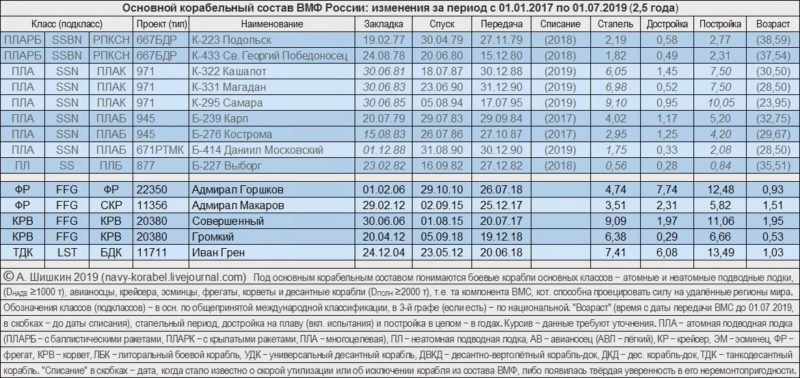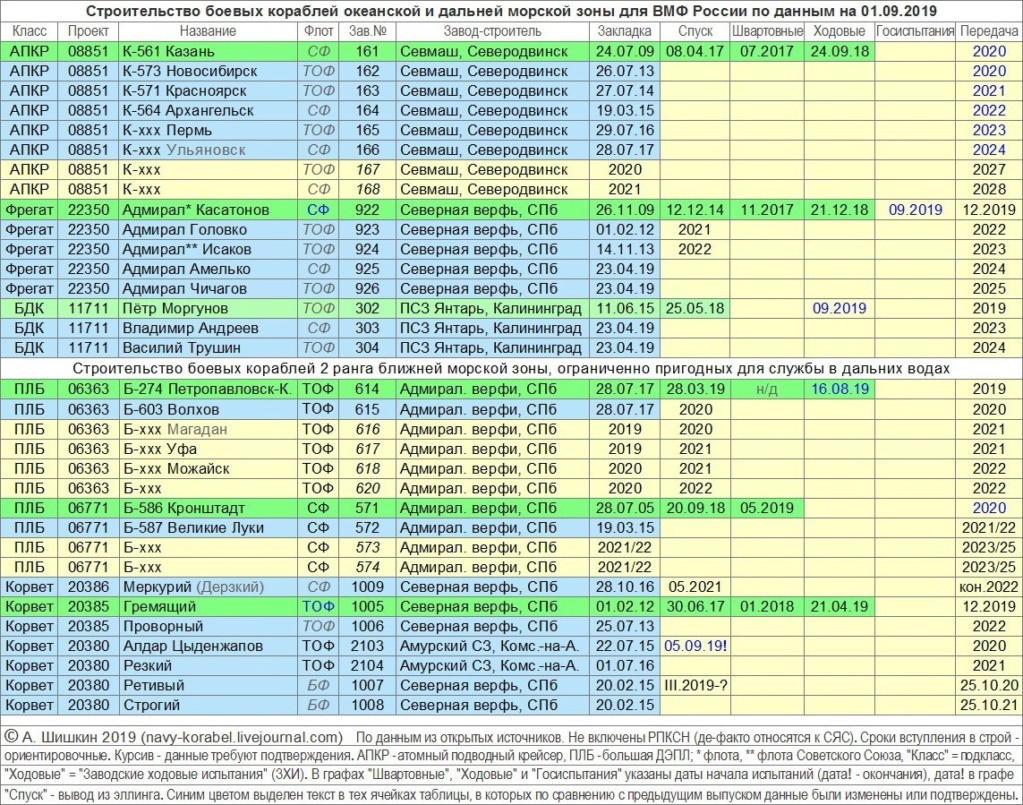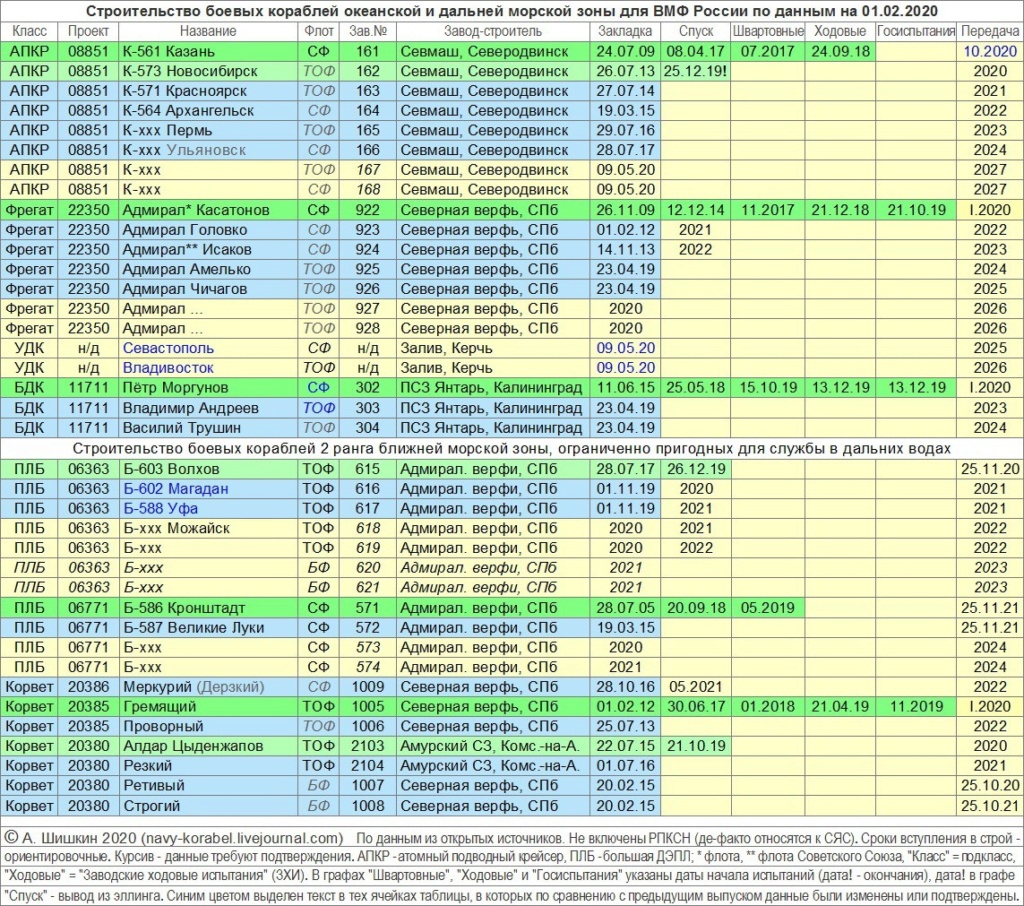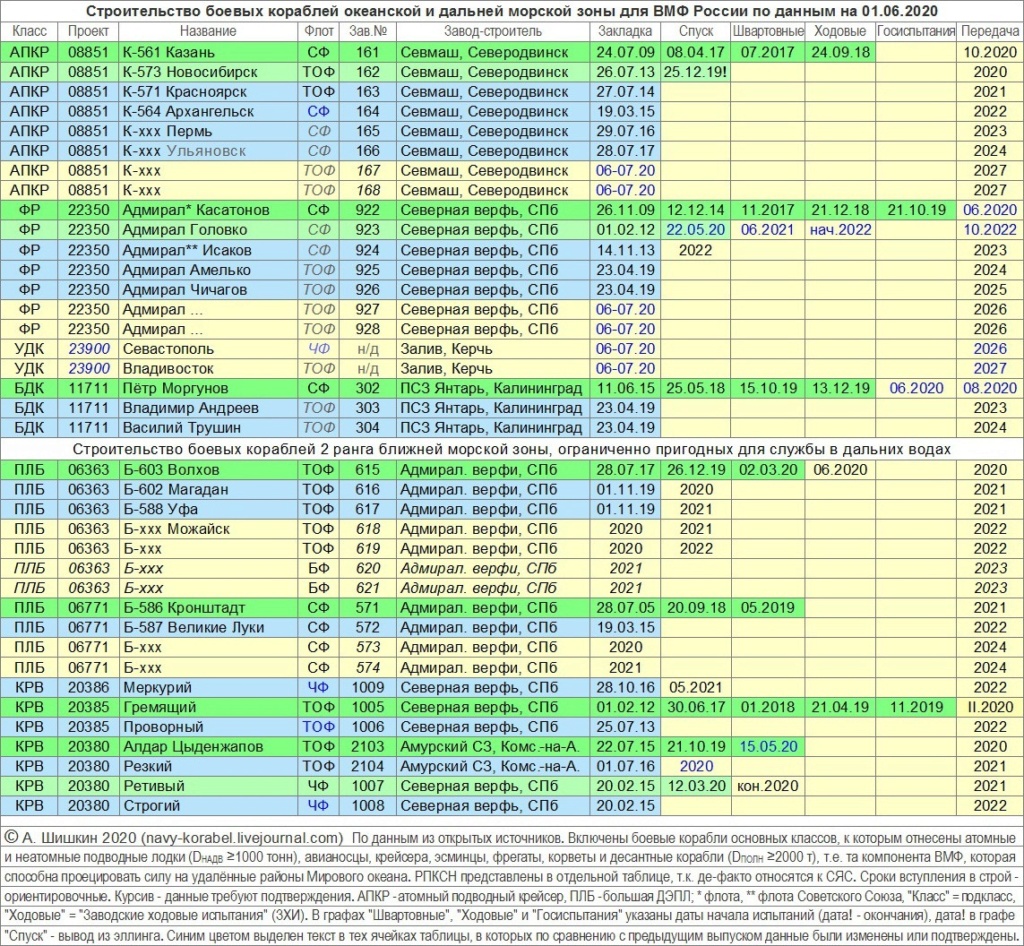1155 (M) −22350 (M): generational change
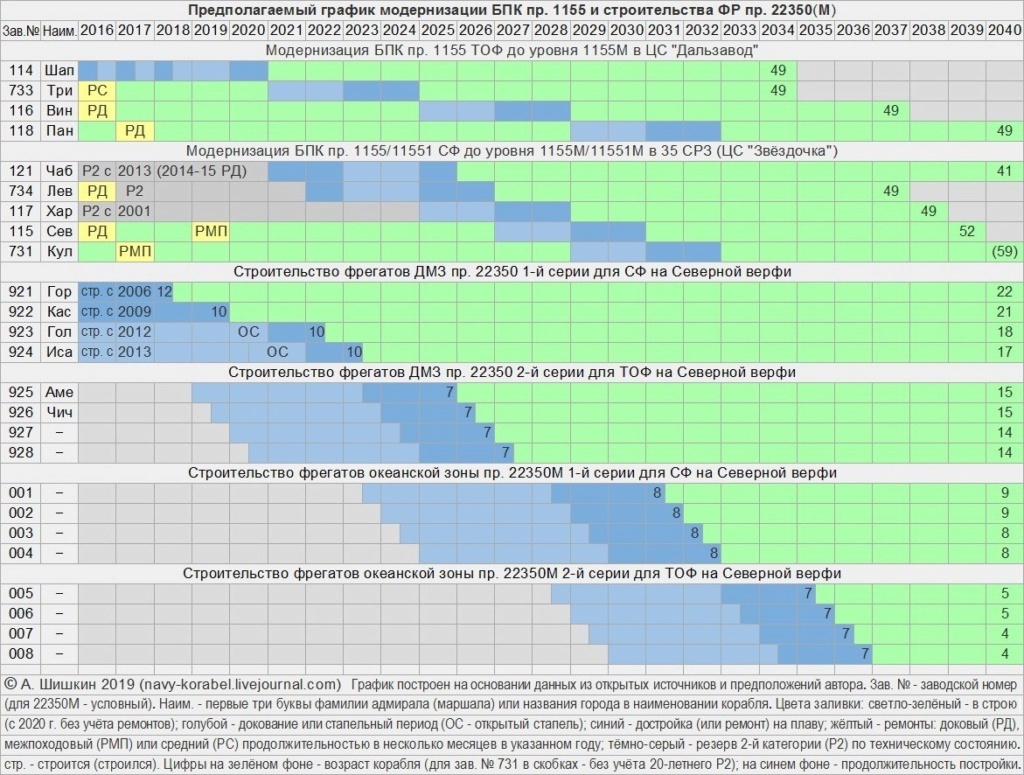
The most relevant and interesting in this context is the modernization and construction of the "workhorses" of the fleet in DMZ / OZ - ships of pr. 1155 (M) and 22350 (M). The results of the corresponding study are presented in a graph based on the following facts and assumptions.
1155M
If the first 1155M (Marshal Shaposhnikov) will be transferred to the Pacific Fleet at the end of 2020, the duration of its average repair with modernization will be about 5 years. Given the fact that the VTG Admiral Tributs (whose main innovation was the replacement of the Lev SUAO with Bagira) took 2.5 years, one can hope to reduce the length of stay in Dalzavod following 1155 to 4 years at best, two of which they will spend in the dock. The DAC would probably be able to accept two BODs for repair at once, but this would most negatively affect the combat effectiveness of the surface group of the Pacific Fleet, therefore, a consistent modernization scheme was adopted, in which, as part of the permanent readiness forces of the Pacific Fleet until 2032, incl. there will always be a minimum of three ships, pr. 1155 and 1155M [1].
Note [1]. The lifespan of the improved (updated) 1155 is “assigned” within 8-14 years (when Chirkov announced 10-15 years - reference 5) with the condition that the calendar age of the ships will not exceed 52 years (for comparison: TFR "Sharp" without which or a serious modernization has served exactly half a century). The 59-year-old age of the Kulakov, however, is not indicative, since the ship spent 20 years in a protracted repair.
The schedule for modernization of the Northern Fleet's BOD (projects 1155M and 11551M, presumably, will not differ much from each other) directly depends on the deadline for completing work at Kuznetsovo. The obligations of the Zvyozdochka TS under the TAVKR repair contract end in the fourth quarter. 2022 (ref. 6). Prior to the final docking of the aircraft carrier (for revision and painting after the ZHI) dry dock 35 SRZ can be considered inaccessible.
First will be modernized the "Chabanenko". Given the possible delay in documentation (the documentation should be ready by the end of this year - ref. 7), work will begin afloat in 2021, in the dock in 2023, and their total duration is likely to be at least 5 years. Along with the only 11551, it will be possible to dock one of 1155 [2] - say, Levchenko (pending repair from 2017) with the same period of modernization work. Further, the three remaining BODs (Kharlamov [3], Severomorsk, Kulakov) can be updated according to the same scheme as in the Far East (in order not to impede the VTG of other BFs of the SF) for a period of 4 years ( 2 at the dock).
Note [2]. According to the reconstruction project of the docking complex 35 SRZ (which may be dedicated to a separate entry), two ships with a maximum length of 163.5 m can be placed in parallel on two lateral slipway lines in the 180-meter end chamber of the reconstructed dry dock, separated from the other by interchangeable intermediate shutter (ref. 8 [contents], p. 4).
Note [3]. Repair of "Kharlamov" seems a miracle, which can still be hoped for, despite the facts. As can be seen from the graph, the restoration of the ship is possible only in 2025 (24 years after the withdrawal to the reserve), if you change it from Levchenko (which is unreasonable) - three years earlier. From such a long sludge, Soviet 3rd generation BNCs have not yet returned (for comparison: the repair of Irkutsk began after 12 years of nonexistence, and Nakhimov after 15 years). There is every reason to believe that the head. No. 117 has long been used as a "donor".
22350Information on frigates of Project 22350 was taken from the construction schedules for ships of the main classes for the Russian Navy, regularly published on the blog (link 11) and entries by the corresponding tag (link 12). The reasons why the 1st (base) series production ships are being built for 10 years should be clear: Kasatonov was waiting for the completion of the Gorshkov air defense system and, probably, the elimination of other shortcomings identified in the tests of the head order; “Golovko” and “Isakov” are waiting for the DHTA, created under the import substitution program.
There is confidence that the frigates of the 2nd series will be built faster. Taking into account minor design differences (mainly 3x8 place 2x8 UKKS - ref. 13, ref. 14) and accumulated production experience, with an error, rather, in a safe direction, their construction time can be estimated at about 7 years. As for the duty station 22350, it can be assumed that not only the Gorshkov and Kasatonov, but all 4 ships of the 1st series will be part of the Northern Fleet. To think so, among other things, allows the fact that the names of admirals Golovko and Isakov are inextricably linked with the history of the Northern Fleet - the first commanded the fleet throughout the Great Patriotic War, the second stood at the origins of its formation (EON-1, EON-2 [4] ) Frigates of the 2nd series in justice should replenish the Pacific Fleet.
Note [4]. The recent history of the Northern Fleet begins with the formation of the Northern Naval Flotilla in 1933 by transferring nine ships of the Baltic Fleet (three destroyers of the Novik type, three ASF of the Hurricane type and three submarines of the D type) along the White Sea-Baltic Canal as part of the expeditions special purpose No. 1 and No. 2. I. Isakov was the chief of staff of EON-1 and the commander of EON-2.
1155 and 22350: inverse proportionHaving one and a half times less displacement (5400 against, according to various sources, 8250/7550 [5] tons full), frigates of Project 22350 will surpass 1155M in terms of aggregate combat capabilities. Their main advantage is the presence of a zonal air defense system, which with a probability close to 100% will not be present on modernized 1155 (at best, they will be limited to installing a Tor-MF short-range air defense system [Tor-M2KM] instead of a “Dagger”) . Even if the 1155M receive Uranus missile launchers (in addition to the 2x8 UVX UKKS), they will be inferior to the improved 22350 (3x8 UKKS) in terms of strike power, their AK-100 AU is slightly inferior to the A-192 in firing range (21.5 / 23 km) and twice as much in terms of the mass of the projectile (15.6 / 33.4 kg), and radio-technical weapons and the level of visibility in physical fields cannot be compared to the 4th generation ships. PLO and PTZ are too early to compare, but there should be no surprises here.
Note [5]. Yu. Apalkov and V. Kuzin with V. Nikolsky give for base 1155 6930/7570 t standard / full, A. Pavlov - 6945/7570, V. Muratov - 6880/7560/8250 standard / normal / full.
In turn, 1155 (M) due to their greater displacement have a larger air group (two helicopters instead of one) and better seaworthiness. Nevertheless, the round-the-world voyage of the Gorshkov clearly demonstrated the ability of the 22350 to operate in the open ocean for a long time. Ultimately, as long as the frigates of the far 4th marine zone are generally superior to the modernized BODs of the 3rd generation ocean zone, they can be rightfully considered a worthy replacement for the 1155 base project.
22350M
There is evidence that the conceptual design of the oceanic 22350M [6] was developed by the Northern Design Bureau by the end of autumn, and its approval should take place before the end of this year. (ref. 15). At a recent press conference in Interfax, the head of USC, as always, slurred that the upgraded version of 22350 would be created by 2022 (ref. 16). If we mean by "creation" the approval of the technical project, and "by 2022" - "in 2022" (that is, until the end of the named year), the laying of the lead ship should be expected in 2023. The duration of the construction of the first four, we hope, will not more than 8 years, followed by a decrease to 7 years.
For the second series 22350 and 22350M, the schedule is based on the fact that four orders with a maximum length of 170 m and a width of 21 m can be built simultaneously on 4 slip lines in the existing boathouse of the Northern Shipyard (22350M will have about 160x19 m). As in the case of the fifth or sixth hulls 22350 (and the third and fourth hulls 11711), they can lay down two ships at once, however, the beginning of work on the slipway on the schedule is spaced out for six months. At the final stage of the slipway period, which, by analogy with 11356, should last about 2/3 of the total construction period, orders can be transferred for an open slipway with three lines of 170x27 m each (ref. 17).
With the start of the serial construction of frigates of the ocean zone, it would be wise to transfer less priority orders (22350, 20380/20385) to other shipyards, say, the Baltic "Yantar" and the Far Eastern Shipyard. The prospective boathouse of the North East, the capacities of the Baltic Shipyard and the promising SSK Zvezda, in turn, are more expedient to use for the construction of destroyers (cruisers), pr. 23560.
Note [6]. According to available information, the 22350M will have a total displacement of about 8,000 tons (ref. 18, ref. 20) (the same as 1155 and 956) and carry 48 strike missiles and about 100 SAMs (ref. 22), which corresponds to 6 UKKSK modules and 8 air defense systems " Polyment-Redoubt "with 8 cells each (48 plus 64 - a total of 112 cells versus 96 for Burka IIA), provided that 12 short-range SAM systems will contain 4 9M100 short-range SAMs (ref. 23).
Conclusions
The above on the graph and in the text should not be regarded as an attempt to predict the future - this is just information for reflection on the topic of updating the Russian Navy. In fact, the deadlines and the number of orders of a project can either increase or decrease depending on certain circumstances. Nevertheless, some conclusions can already be drawn.
Conclusion number 1. Taking into account the imminent (in 2023) completion of the formation on the Northern Fleet of 22350 grouping in the amount of 4 units, the need to modernize the North Sea BOD to the level of 1155M seems far from obvious. The foregoing does not apply to Chabanenko, the repair of which, without a doubt, will be completed. At the same time, the combat readiness of two or three 1155 should be maintained until the flag is hoisted in the first 22350M.
Conclusion number 2. The Pacific Fleet, which will be replenished with four 22350s not earlier than 2027, on the contrary, needs to continue the modernization of its BOD (although perhaps not in full).
Conclusion number 3. The construction of the 22350 and 22350M, of course, should not be limited to those presented on the schedule. The minimum required number of ships of each project on each of the two ocean fleets, according to the author, is 6 units, ideally - 12 (with a total of 2x12 22350M and 2x12 22350).
https://navy-korabel.livejournal.com/226046.html








